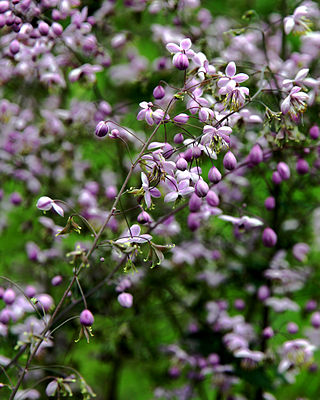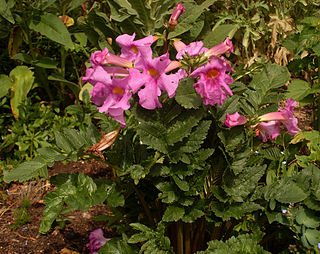
Cladrastis (yellowwood) is a genus of flowering plants in the family Fabaceae. It includes four species, three native to eastern Asia and one to southeastern North America.

Apios is a genus of flowering plants in the family Fabaceae. It belongs to the subfamily Faboideae. It contains seven species of perennial climbing herbs or scandent shrubs. Several members of this genus are known to have edible, tuberous roots.

Thalictrum delavayi, Chinese meadow-rue, is a species of flowering plant in the family Ranunculaceae native to China. Growing to 1.2 m (4 ft) tall by 60 cm (24 in) wide, it is a herbaceous perennial with leaves divided into many small leaflets, and panicles of lilac flowers with green or white stamens in summer.
Quercus delavayi is an Asian species of trees in the beech family. It has been found only in southern China, in the Provinces of Guizhou, Hubei, Sichuan, Yunnan, and Guangxi. It is placed in subgenus Cerris, section Cyclobalanopsis.

Incarvillea delavayi, the so‑called hardy gloxinia or flowering fern, is a species of flowering plant in the family Bignoniaceae, native to western Sichuan and northwest Yunnan provinces of China. The true Gloxinia are members of the Gesneriaceae, while true ferns are flowerless plants which reproduce through spores.

Carex angustisquama is a tussock-forming species of perennial sedge in the family Cyperaceae. It is native to northern parts of Honshu in Japan.
Carex aphanolepis is a tussock-forming species of perennial sedge in the family Cyperaceae. It is native to eastern parts of Asia.
Carex bodinieri is a tussock-forming species of perennial sedge in the family Cyperaceae. It is native to Japan and eastern parts of China.

Carex curvicollis is a tussock-forming species of perennial sedge in the family Cyperaceae. It is native to parts of Japan.
Carex capilliformis is a tussock-forming species of perennial sedge in the family Cyperaceae. It is native to central parts of China.
Carex cylindrostachys is a tussock-forming species of perennial sedge in the family Cyperaceae. It is native to parts of Yunnan and Sichuan in China. It's common name in Chinese is zhu sui tai cao, or 柱穗薹草.
Carex davidii is a tussock-forming species of perennial sedge in the family Cyperaceae. It is native to parts of China.

Carex dissitiflora is a tussock-forming species of perennial sedge in the family Cyperaceae. It is native to parts of Japan and Taiwan.
Carex fastigiata is a tussock-forming species of perennial sedge in the family Cyperaceae. It is native to parts of Tibet, Nepal and China.
Carex fulta is a tussock-forming species of perennial sedge in the family Cyperaceae. It is native to parts of Honshu in Japan.
Carex makinoensis, also known as tufted rock-living sedge' is a tussock-forming species of perennial sedge in the family Cyperaceae. It is native to parts of South Korea, Taiwan and Japan.

Carex mitrata, also known as mitra sedge is a tussock-forming species of perennial sedge in the family Cyperaceae. It is native to Japan, Korea, Taiwan and eastern parts of China.

Carex shimidzensis is a tussock-forming species of perennial sedge in the family Cyperaceae. It is native to parts of Japan, Korea and the Kuril Islands.

Carex dickinsii, also known as Dickins' sedge or chao xian tai cao in pinyin, is a tussock-forming species of perennial sedge in the family Cyperaceae. It is native to parts of Japan, Taiwan and south-eastern China.









